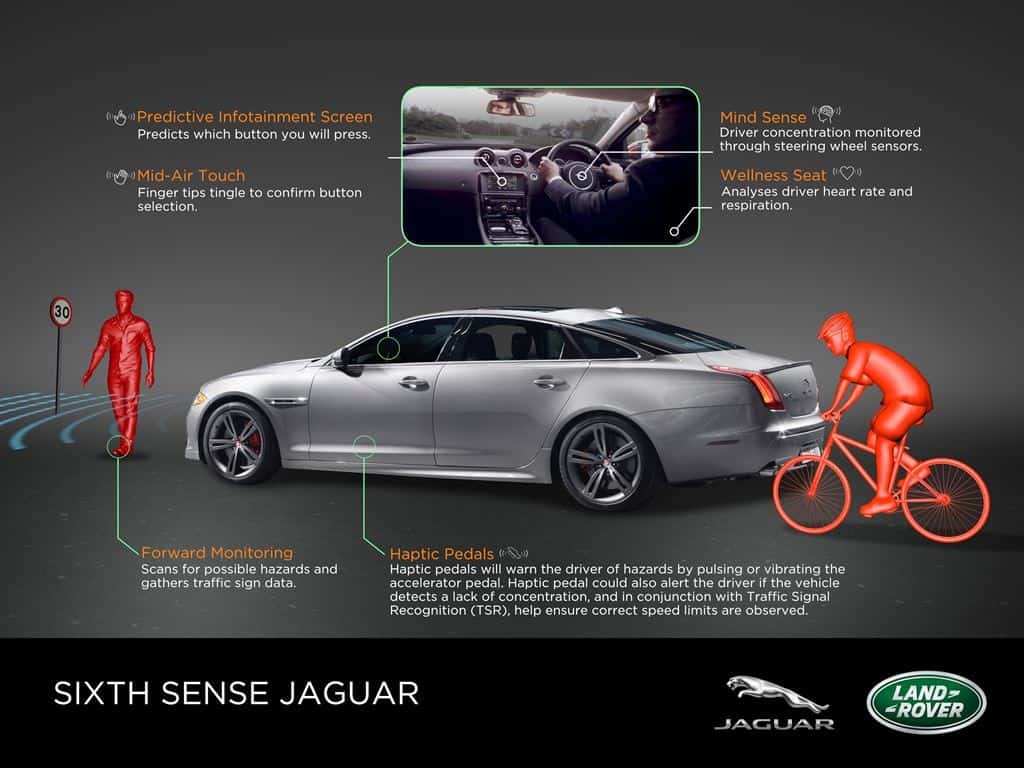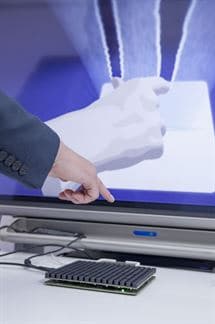 Jaguar Land Rover has been touting its new road safety technology research projects, lately, including a remote control app and pothole detection. The company is also researching brain alertness, body vitals via seat sensors, touchless haptic screens and sensational pedals that notify the driver of hazards by vibrations and resistance.
Jaguar Land Rover has been touting its new road safety technology research projects, lately, including a remote control app and pothole detection. The company is also researching brain alertness, body vitals via seat sensors, touchless haptic screens and sensational pedals that notify the driver of hazards by vibrations and resistance.
Brains Waving Signals of Concentration
The research project ‘Sixth Sense’ measures brain waves, stress, body vitals and more to sense if the driver is awake and paying attention. Brainwaves will show even if the eyes are on the road, a lack of concentration or a daydream showing that the driver isn’t paying attention while driving.
Our Wellness Seat can detect if the driver is stressed or is seriously ill #research #technology pic.twitter.com/dmcT6EJ2qw
— Jaguar Land Rover (@JLRPR) June 17, 2015
Based on technology used to train NASA pilots to concentrate, sensors in the steering wheel detect brain waves to check the concentration level of the driver. To improve the sensing of brainwaves software is used to amplify signals. Trials will collect more information will include leading neuroscientists in the project to verify the results.
Seat of Pants Monitoring
JLR is testing ways to monitor the well-being of the driver using a medical-grade sensors that detect vibration, heartbeats and breathing embedded in the seat of a Jaguar XJ.
If the car detects severe health issues or alertness so the car can respond. Sensors could monitor driver stress levels then to help reduce stress change the lighting, audio settings and climate control.
Predictive Infotainment Screen with mid-air touch
 Jaguar Land Rover is working on touchscreen that doesn’t have to be touched to minimize time looking at the screen. A Predictive Infotainment Screen prototype uses cameras to track the driver’s hand movements then predicts the button the driver wants to tap. Button selection takes place in mid-air. In tests the speed of successful button selection was improved by 22%.
Jaguar Land Rover is working on touchscreen that doesn’t have to be touched to minimize time looking at the screen. A Predictive Infotainment Screen prototype uses cameras to track the driver’s hand movements then predicts the button the driver wants to tap. Button selection takes place in mid-air. In tests the speed of successful button selection was improved by 22%.
Mid-air touch could also offer the driver ultrasonic haptic feedback, that their button push worked. It would feel like a ‘tap’ or a ‘tingling’ on your fingertips, therefore the driver doesn’t have to look at the screen to see if the task was completed.
Sensational Haptic Gas Pedal
Haptics could also be used to communicate with the driver through the accelerator pedal. Vibrations, pulses or resistance are passed through to the foot of the driver.
This resistance could be used to notify the driver that they are pushing the accelerator through a speed limit. Driving slowly in traffic a warning through the accelerator could prevent the driver bumping into the car in front.
Haptic pedals allow for non-visual ways to communicate which would enable the driver to make faster decisions and reduce the potential for accidents.